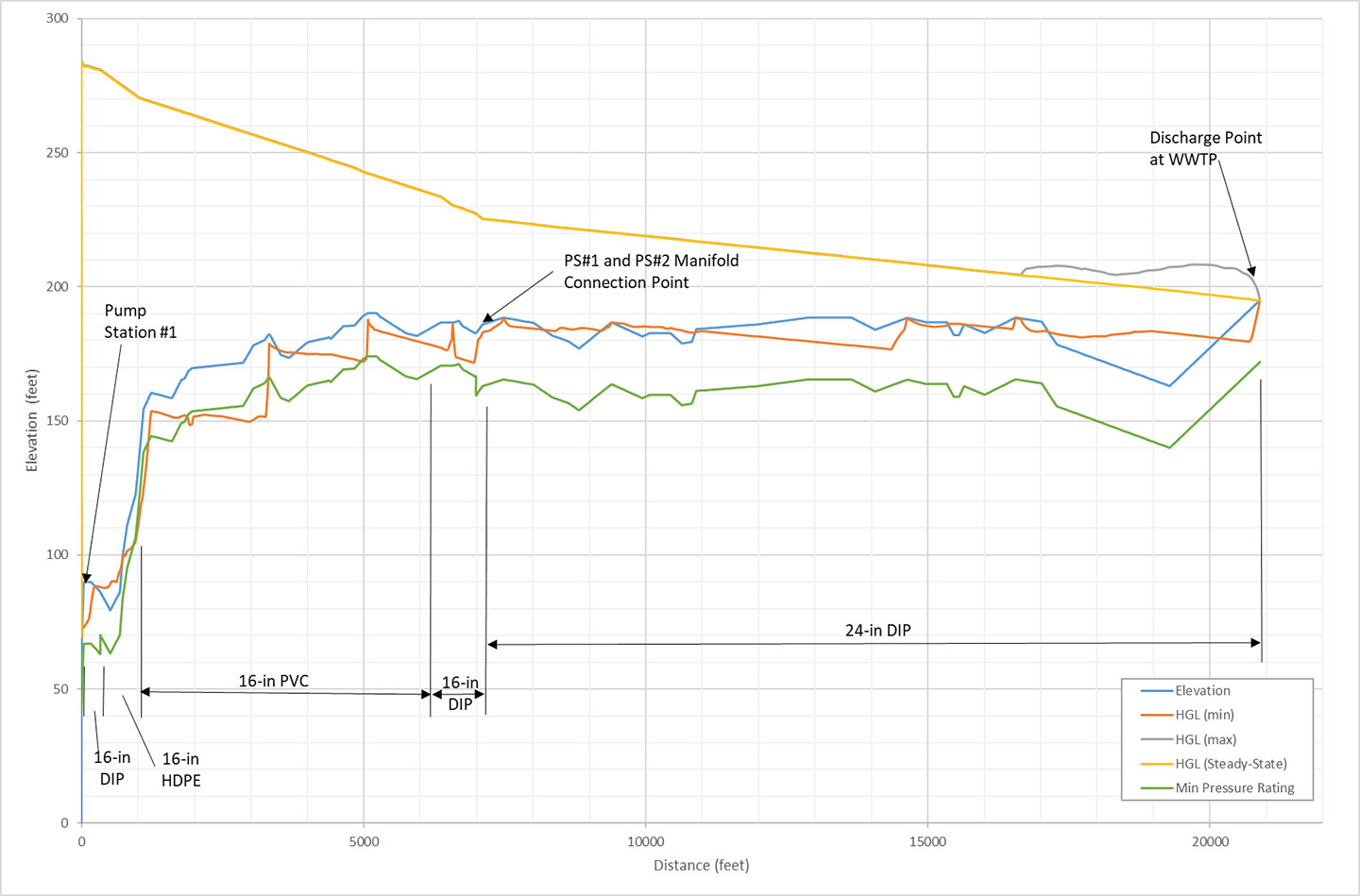Counties, cities, and towns depend on their water and wastewater infrastructure to be resilient in order to provide the residents and businesses they serve with reliable sewer and water service. Proactive analysis of critical pumping systems, including
sewer pump stations and force mains, and water booster stations and transmission mains is vital to mitigating the risk of system failures during a range of operating conditions. Transient analyses utilize computer-based hydraulic modeling to simulate
how a system reacts to potentially catastrophic scenarios and provide recommendations to minimize damage to these facilities and disruption of service. Understanding our clients’ water and sewer infrastructure while protecting the environment
and maintaining service to their customers are the driving factors that make transient analysis a critical step in the evaluation and design of water and wastewater systems.
Understanding the Process
A transient event is an extreme pressure event within a pressurized system that can result in severe high-pressure spikes or vacuum conditions throughout the length of the pipe network and may result in leakage, breaks, or collapses. Primarily, a transient
analysis simulates these worst-case scenarios in a pressurized system. Transient waves occur as a result of abrupt changes in the system, like a pump suddenly shutting down due to a loss of power, a valve closing too quickly, or even during normal
pump starts and stops. By simulating these types of events, we can provide operational and design recommendations to mitigate our client’s risk by reducing the occurrence or preventing transient events.
How It’s Being Used Successfully
There are several ways in which we’re using this tool to help our clients fulfill their needs. The first is in the preliminary design stage of new pump stations and pipeline systems. We use this tool as standard practice when designing new pump
stations, whether they are wastewater, water pump stations, or long transmission or distribution pipelines. It is used so that we are designing and building systems that are safe, effective, and minimize risk. By evaluating the results of our transient
model, we can size and locate transient mitigation devices throughout a system, such as air release valves, surge relief valves, change pipe class/wall thickness, or pipe materials.
Similar to the preliminary design stage, we are able to use the tool to evaluate upgrades and rehabilitations of existing pump stations and pipelines. We recently completed several projects where we used transient analyses and were able to locate multiple
transient mitigation devices throughout a force main to minimize excessive maximum or minimum pressures (vacuum conditions) during transient events. The installation of combination air-vacuum relief valves and a recommendation of a surge-relief line
decreased the risk of damage in an existing system with an aging force main.
The final way we are using this tool is pipe material and pressure class/wall thickness selection. Because different pipe materials react differently during a transient event, we can simulate multiple transient conditions for various types of pipe materials
in the force main so each will have adequate strength to convey flows under a transient condition. This informs material selection process and ultimately saves money because we can identify the most economical materials needed to withstand the anticipated
transient events.
Understanding our clients’ water and sewer infrastructure while protecting the environment and maintaining service to their customers are the driving factors that make transient analysis a critical step in the evaluation and design of water and
wastewater systems. ”
Carl Bundschuh and Richard Kincheloe
Using Expertise to Raise Industry Standards
Our firm is seeing transient analysis play a growing role in defining the levels of design and modeling service criteria. One of the many challenges with this type of tool is trying to obtain a digital twin of a portion of a water system, so we use our
in-house experts to create the most accurate representation possible. Our main goal with this tool is to be able to improve system resilience to these types of events so that we're protecting our clients’ valuable assets and helping municipalities
continue to provide water and sanitary sewer service for their customers.
 High-pressure spikes and low-pressure drops along a force main with multiple pipe materials
High-pressure spikes and low-pressure drops along a force main with multiple pipe materials